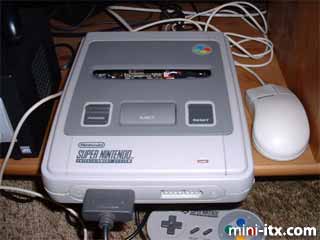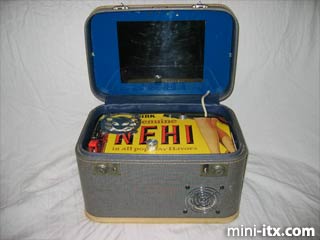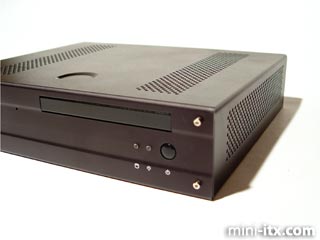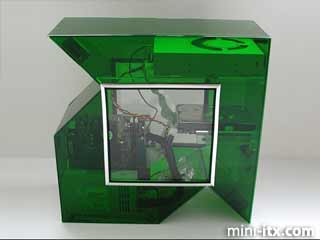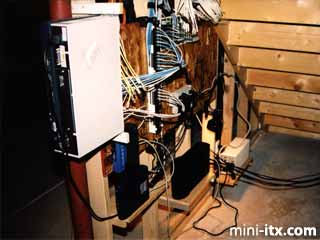Home | News Archive | October 2003
Simtec's ARM9-based Mini-ITX board
October 29, 2003
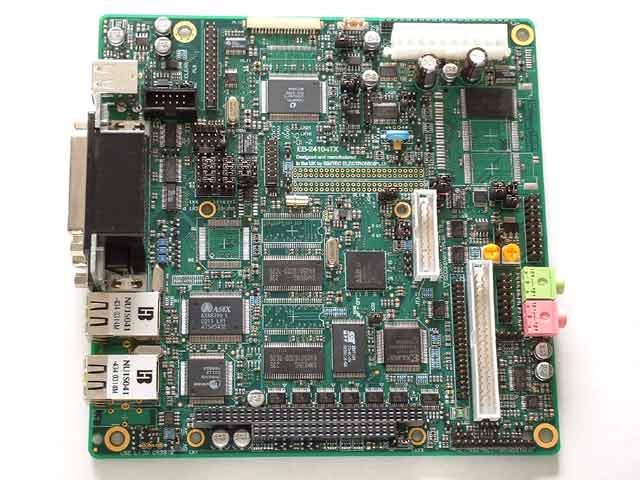
Simtec Electronics in the UK have released a Mini-ITX sized Samsung 2410 evaluation board based on a 266Mhz Samsung S3C2410 ARM9 processor.
There are three standard configurations available, Gold, Silver and Bronze. Key features include up to 256MB on board SDRAM, NAND Flash memory and a Smart Media Slot, integrated video with TV output, VGA and LVDS panel connectors, integral audio, two 10/100 Mbit network controllers, USB host interfaces, up to five UARTS, IDE interfaces and PC/104 expansion. In all configurations, the total power consumption is less than 2W. The board comes with 16MB of FLASH ROM containing Simtec's ABLE firmware, ready to boot your choice of operating system. A supplied support CD contains a complete cross compiling GNU toolchain which is configured to produce example embedded applications including an electronic picture frame, simple thin client web browser, NAS unit and E-book reader.
Simtec's Samsung 2410 Evaluation Board
The "AnimalSNES"
October 28, 2003
Chris Phillips didn't just stuff an EPIA 800 into a very weeny Super Nintendo. He scorned at installing a hard drive, preferring to boot the AnimalSNES over his LAN using PXE - and he runs MPlayer on Gentoo for DivX playback. He's very kindly explained how he did all that clever stuff.
C5P article at ExtremeTech
October 27, 2003
ExtremeTech have a nice article about VIA's C5P processor, the codename for the C3 CPU that will live inside next year's Nano-ITX motherboards.
The C5P is a more efficient design of the C5XL (Nehemiah C3) processor. When designing the C5P, VIA took away around 280,000 transistors and added around 180,000 for new security features, keeping all the instructions of the previous Nehemiah and drawing less energy at 1GHz (allowing for a smaller die size). More about those security features - the existing Nehemiah C3 processor already has a hardware RNG (Random Number Generator - useful for encryption), and the son-of-C5XL (C5P) will add to this with full hardware-based AES encryption. This is a canny route for VIA to take - initial tests have shown that an inexpensive C5P based PC will encrypt in hardware with a throughput an order of magnitude faster than the fastest Pentium IV can encrypt in software.
VIA C5P Processor: Small is Beautiful at ExtremeTech.com
The "Osh Kosh"
October 24, 2003
Dustin Smith chose a vintage Osh-Kosh vanity case to create a portable MP3 DJ set up for parties and festivals. Packed inside is an EPIA 9000, additional Video card, an LCD screen, DVD/CDRW, HDD, mouse and roll-up keyboard. And an 8-channel sound reactive EL-wire sequencer that controls 200 feet of colored glow wire...
Traveling with the luggage has made going through airport security much more interesting for Dustin. His favorite security guard comment, made while giving the Osh-Kosh a plastic explosives "swab" test: "A computer? Why'd you do that?" then, before he could answer, he continued: "Because you could, right?". Dustin smiled and nodded.
Robot Platform Design from Roboteq
October 22, 2003
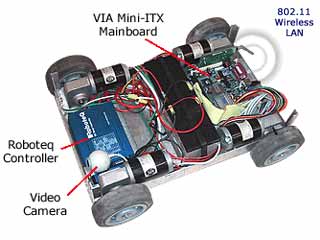
Arizona-based Roboteq was formed only a year ago, but the self-styled "Embedded Systems and Motor Control Specialist" is already producing some impressive ideas. This cute little 4x4 PC reference design is the product of a collaboration with VIA, which considers robotics an important part of the "Total Connectivity" programme it vaunted at VTF last month.
The Robovia consists of a plastic box containing an EPIA M10000, a wireless LAN card to receive directional commands from a PC, a webcam tacked on the front so the remote driver can see what's going on, and a motor for each wheel. The motors receive commands from Robotec's AX2550 controller, which in turn receives instructions via the, errm, from VIA's RS232 port.
We like robots at Mini-ITX. More Robot Projects please...
Building Instructions for the Robovia Reference Design
1U Rackmount Cases from Travla
October 20, 2003
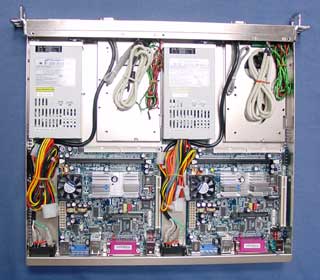
Casetronic (in their guise as Travla) have released details of two new 1U Mini-ITX compatible enclosures, the twin PCI slot capable C146 and the twin Mini-ITX board capable C147.
The Travla C146 is a 19" x 15 "x 1.75" (482.6mm x 381mm x 44.45mm) rack-mountable enclosure supporting 3 x 3.5" internal drive bays, 1 or 2 PCI slots (with optional riser cards), and has a compact flash reader mounting option, front mounted serial port and 2 x USB 2.0 ports. The C146 is cooled by a 75mm blower fan, and powered by a 180W power supply.
The Travla C147 (pictured above) can accept two Mini-ITX motherboards, two compact flash readers, and has one serial and 2 x USB 2.0 ports for each board. The C147 measures exactly the same dimensions as the C146, can mount 2 x 3.5" HDDs or 4 x 2.5" laptop-sized HDDs, and has a 180W power supply for each motherboard.
The "800MHz Teddybear"
October 17, 2003
David "Dadde" Windeståhl performed unspeakable acts of cruelty on his teddybear - grafting his head (the bear's, not his own) onto a new body stuffed with a miniature integrated PC motherboard, hard drive and CDROM. Incredibly, his girlfriend actually liked it. We only present this twisted project as evidence of the crimes committed to bearkind.
David "Dadde" Windeståhl's "800Mhz Teddybear"
Compulab's ATXBASE boards
October 16, 2003
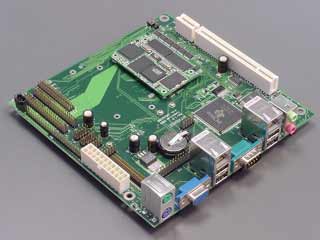
Israeli embedded systems manufacturer Compulab have added Mini-ITX sized BASE units to their range of single board computer modules, available in December. Compulab have an interesting building-block approach - with a range of very small CORE modules containing a CPU and Memory, and two corresponding ranges of BASE units living in symbiosis underneath, providing increased connectivity and functionality. The CORE modules range from the XScale PXA255-powered ARMCORE (consuming <1W, as seen in PocketPCs the world over) to the Celeron/PIII-powered 886CORE, consuming 25 - 40W. There are 3 Mini-ITX sized ATXBASE modules in the works, the ATX-ARM, ATX-886, and ATX-686 - powered by a 2 - 5W National Semiconductor Geode CPU. The above picture shows an ARMCORE module astride an ATXBASE module, making an ATXBASE-ARM. Even smaller are the BASE modules, in a variety of sizes (some even smaller than Nano-ITX). We probably won't be building one into our Big Trak just yet, as they look to be targetted at a slightly more serious market...
Eden-N shown at Microprocessor Forum
October 15, 2003
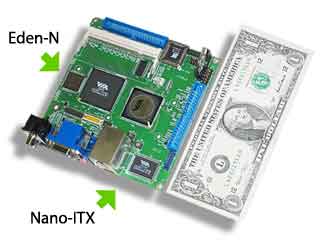
VIA have released more details of the Eden-N at the 16th annual Microprocessor Forum conference in San Jose. The Eden-N is the wee processor to be used in their forthcoming Nano-ITX motherboards. Incredibly, the fingernail sized "nanoBGA" package measures just 15mm square, making the Eden-N the world's smallest native x86 processor. Power consumption is also incredibly small - just 4W at 533Mhz, 6W at 800Mhz and 7W at 1Ghz. The Eden-N has a streamlined Nehemiah architecture, complete with super-fast on-die support for the Advanced Encryption Standard (AES), ideal for securing your e-mails and online transactions, or encrypting your Wi-Fi network.
EPIA CL Linux Firewall/Router Project
October 13, 2003
We thought it was time for another Linux project, so inspired by the Rumba Server Appliance we decided to build a Firewall/Router over the weekend using an EPIA CL and Redhat Linux. The EPIA CL has 2 Network Interfaces on board, making it ideal for use as a basic Two-Interface Firewall, in combination with an ADSL or Cable Modem. This guide will also apply to any EPIA with an additional NIC on a PCI card. The advantage of using the EPIA CL is the PCI slot is kept free, and a smaller enclosure can be chosen - our EPIA CL 6000 fits into a wee Cubid 3677 case and runs in near silence.
EPIA CL Linux Firewall/Router Project
Axentra's Rumba Server Appliance
October 09, 2003
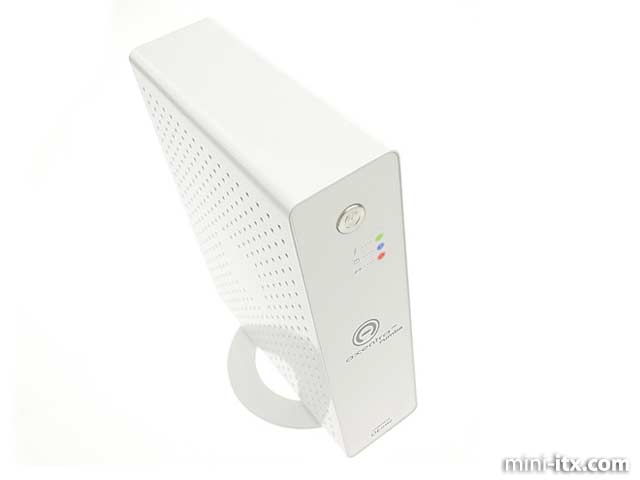
Here's the recipe: take one Mini-ITX compatible motherboard with an 800Mhz C3 CPU, add a couple of additional LAN ports, a 256MB DIMM and a 40GB hard drive. Stir in a Linux distribution preconfigured as an Internet Gateway, connecting to an ADSL or Cable modem and acting as an Ethernet switch. Add services such as Web, File, Email and Print Servers. Protect it with a Firewall, and include Spam, IP and Content filtering. Let the whole thing be configurable through an easy to use web interface, and include Mac and Windows compatibility by using SAMBA. Finally, season with a bundle of web-based applications such as a photo album for sharing those special moments with your internet buddies and co-workers...
Comparisons can be drawn with earlier edge-of-network devices by Sun (Cobalt Qube) and Rebel (the Netwinder). It is not a coincidence that the co-founder of Corel Computer (who developed the original Netwinder Server) is now the CEO of Axentra, based in Ottawa, Canada. Axentra are a relaunched OEone Corporation, who make web-based software similar to that bundled with the Rumba.
Inside the case
The Rumba Server Appliance has 2 x PS2 ports, 2 x USB 1.1 ports, 2 x Serial ports, 3 x LAN sockets, a Parallel port and a VGA connector on its rear panel.
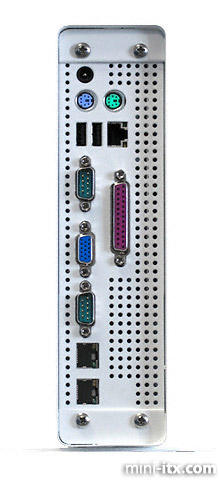
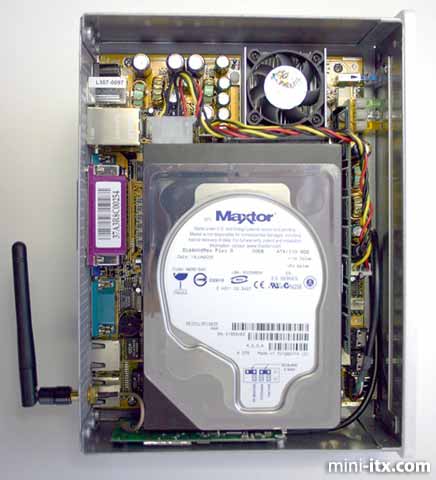
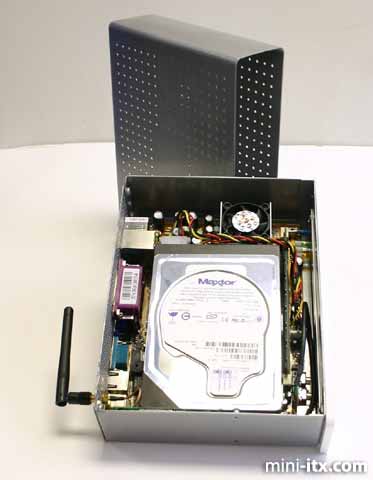
If you take a look inside the case you'll see the inner workings look to be a Lex CV860A-3R80, with a hard drive squeezed in there. The Rumba measures 9.25"x7"x2.31" (235x60x178mm) and weighs 5lb (2.3Kg).
Travla C137 Mini-ITX Case Review
October 08, 2003
Travla is a new brand created by Casetronic to supply a range of quality Mini-ITX enclosures to the market. The Travla C137 is a pizza box format case supporting 2 PCI cards on an EPIA in a small form factor, something no other mainstream Mini-ITX case can currently do.
Travla C137 Mini-ITX Case Review
The "AMD Case"
October 07, 2003
Alex "Spider Case" Wiley sent us pictures of his AMD logo-inspired acrylic case. He used a Mini-ITX board to keep the costs and size down, though the irony of a C3 CPU inside an AMD case makes most people cringe...
The "Tux Server"
October 06, 2003
Michael Charrier created the Tux Server, a Network Attached Storage Device powered by an EPIA 800 inside the shell of a dead Quantum Snap Server. The Tux Server manages to cram 7 drives into the case, including six 2.5" Laptop-style Hard Drives (picked up from a local asset recovery company) arranged in a RAID-5 software array. It runs Linux of course. Here it is (middle right) underneath the stairs, keeping tabs on his UPS...
Michael Charrier's "Tux Server"
More Tranquil PC Options
October 03, 2003
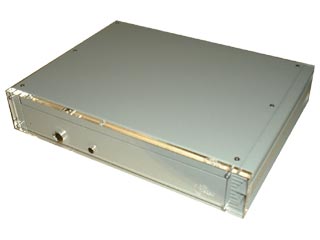
Tranquil PC have a new configuration option - a Tranquil PC without an optical drive, and a blank front panel instead of a drive bay. Useful for those silent server stylee applications. And you could always install Linux using PXE... Ready to purchase here
The Tranquil Media Centre
Tranquil PC will soon be releasing the TMC1 (Tranquil Media Centre), a specially configured and optimised Tranquil PC, Digital TV capture card, remote control and software combo designed to perform those inevitable multelemediaphotimeshiftingtunerpc duties right out of the box. The setup will able to Play/Pause Live TV, use an EPG (Electronic Programme Guide), stream TV over a LAN, as well as the usual DVD and MP3 playback duties - all in near silence.
Sign up to receive early bird purchasing information here
Update 5th Nov 2003: The TMC has been renamed as the Tranquil Media Gold. Other features remain the same (and a few new ones we've recently heard about look rather enticing..)
 |
 |
 |
Quick Links
Mailing Lists:
Mini-ITX Store
Projects:
Show Random
Accordion-ITX
Aircraft Carrier
Ambulator 1
AMD Case
Ammo Box
Ammo Tux
AmmoLAN
amPC
Animal SNES
Atari 800 ITX
Attache Server
Aunt Hagar's Mini-ITX
Bantam PC
BBC ITX B
Bender PC
Biscuit Tin PC
Blue Plate
BlueBox
BMW PC
Borg Appliance
Briefcase PC
Bubbacomp
C1541 Disk Drive
C64 @ 933MHz
CardboardCube
CAUV 2008
CBM ITX-64
Coelacanth-PC
Cool Cube
Deco Box
Devilcat
DOS Head Unit
Dreamcast PC
E.T.PC
Eden VAX
EdenStation IPX
Encyclomedia
Falcon-ITX
Florian
Frame
FS-RouterSwitch
G4 Cube PC
GasCan PC
Gingerbread
Gramaphone-ITX-HD
GTA-PC
Guitar PC
Guitar Workstation
Gumball PC
Hirschmann
HTPC
HTPC2
Humidor 64
Humidor CL
Humidor II
Humidor M
Humidor PC
Humidor V
I.C.E. Unit
i64XBOX
i-EPIA
iGrill
ITX Helmet
ITX TV
ITX-Laptop
Jeannie
Jukebox ITX
KiSA 444
K'nex ITX
Leela PC
Lego 0933 PC
Legobox
Log Cabin PC
Lunchbox PC
Mac-ITX
Manga Doll
Mantle Radio
Mediabox
Mega-ITX
Micro TV
Mini Falcon
Mini Mesh Box
Mini-Cluster
Mobile-BlackBox
Moo Cow Moo
Mr OMNI
NAS4Free
NESPC
OpenELEC
Osh Kosh
Pet ITX
Pictureframe PC
Playstation 2 PC
Playstation PC
Project NFF
PSU PC
Quiet Cubid
R2D2PC
Racing The Light
RadioSphere
Restomod TV
Robotica 2003
Rundfunker
SaturnPC
S-CUBE
SEGA-ITX
SpaceCase
SpacePanel
Spartan Bluebird
Spider Case
Supra-Server
Teddybear
Telefunken 2003
TERA-ITX
The Clock
ToAsTOr
Tortoise Beetle
Tux Server
Underwood No.5
Waffle Iron PC
Windows XP Box
Wraith SE/30
XBMC-ION

